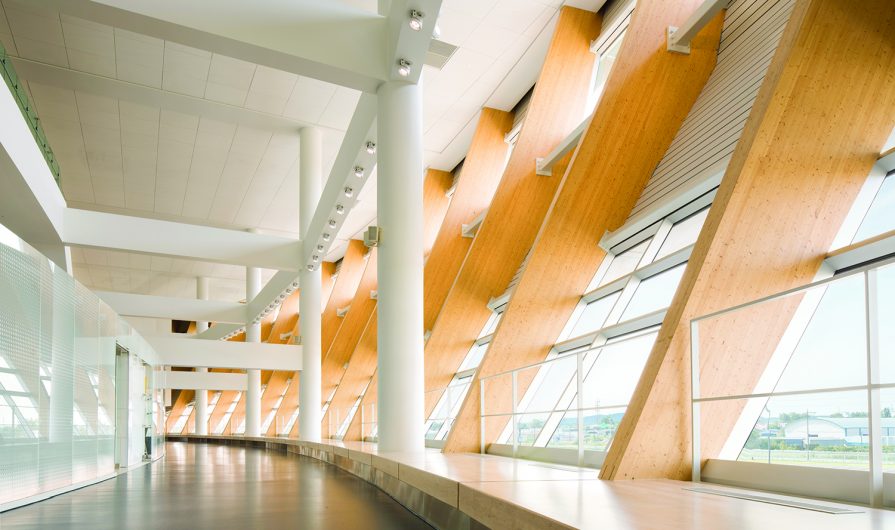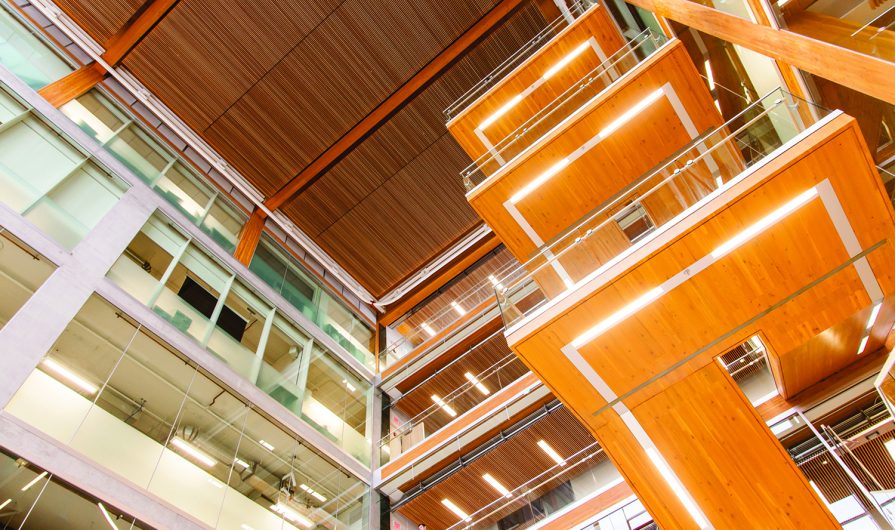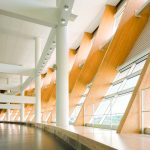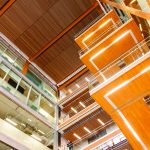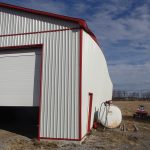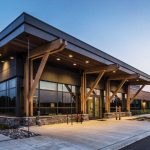Sjoerd Bos
As mass timber construction continues to grow, architects are faced with a multitude of coating decisions based on each building’s unique needs. Too often, a one-size-fits-all approach is taken when it comes to coatings for mass timber construction, an approach that comes with some risks. While budget and timing are factors, it is important to understand the outcomes of various coating-related decisions such as the trade-offs of applying one coat versus two coats, the value of applying an undercoat or primer, and the pros and cons of machine versus hand application of the coating.
Cross-laminated timber (CLT) has been used in Europe extensively and is growing in popularity in North America. In fact, the global CLT market is expected to exceed $2 billion by the year 2025, according to Grand View Research, Inc. Increasingly, five- and six-story wood buildings are gaining ground against traditional concrete and steel shells as designers and developers embrace timber’s potential for lower costs, faster installation and a significantly lighter carbon footprint.
Supportive government initiatives
Momentum is growing. The 2021 International Building Code will allow mass timber construction for structures as high as 18 stories in the U.S. After years of study and research, Canada has also made mass timber a more feasible option. Per the 2015 Model National Building Code of Canada, the maximum height for mid-rise wood-frame construction has been lifted from four to six stories. Numerous projects have already been designed and built to these new building code requirements and more are coming.
Benefits of mass timber construction
There are many reasons why taller timber construction is gaining a strong foothold – from economic and aesthetic to environmental. When managed sustainably, wood is a renewable resource and an effective carbon capture system; carbon remains stored throughout the lifecycle of the wood products – even after disposal when wood fiber is recycled.
Tall timber structures also deliver excellent fire and earthquake resistance. Wood structures perform very well when faced with wind and seismic activity due to the lightweight nature of the wood, ductile connections, and redundant load paths. If mass timber is exposed to fire, the outer layer burns and creates a protective charring layer that slows down combustion, offering a natural barrier against flames. The char layer acts as insulation, delaying the transfer of heat to the cold layer of wood below. Because of mass timber’s density, it also means there are no empty spaces through which air and fire can travel.
According to Think Wood, which partners with various industry groups to promote the economic, environmental and societal benefits of using softwood lumber in commercial, community and non-residential building applications, another advantage of mass timber construction is that it offers a shorter construction schedule, which ultimately lowers construction costs. Well-suited to prefabrication, mass timber components can be manufactured off-site and delivered quickly to the job site. This can considerably reduce a worksite footprint and significantly improve construction times.
The aesthetic, health and wellness properties of wood cannot be overstated. Timber buildings, especially those where the wood is featured and left exposed, have a positive impact on occupants. A 2015 study from Planet Ark entitled, Wood – Housing, Health, Humanity, showed that students in classrooms featuring more wood have lower heart rates and stress responses than students in classrooms using primarily plastic and metal.
Why coatings matter
Wood is clearly a strong, versatile, and environmentally friendly building material. Although it also has some natural protective properties, wood is subjected to a range of weathering factors and possible biological/physical degradation during its service life. The impact of these factors can be significantly minimized with protective coatings. Furthermore, for architectural purposes, coatings can enhance and highlight wood’s aesthetic properties in natural or translucent colors or create stunning architectural features with more opaque or weathered tones.
Ultimately, design and construction are just the first steps in a building’s journey. An appropriate coating can help ensure a building will perform well over time, reducing time-consuming maintenance costs for the owner and allowing the mass timber structure to stand as a testament to the beauty and longevity of wood construction.
Factors impacting coating decisions
There are several factors to consider that can impact a coating recommendation and the final outcome.
When determining the appropriate coating and maintenance interval, it’s important to look at the wood species/substrate, its expected exposure, and whether it will be used for an interior or exterior application. Based on this starting point, the impact of weathering and biological/physical factors such as UV exposure, humidity, exposure to traffic/human touch or pollutants, and temperature range can be evaluated. Nevertheless, the type of wood and the conditions it will be exposed to in situ are only part of the equation. Coatings must also be properly applied.
In factory settings, undercoats and topcoats can be applied under exacting conditions, with temperature and humidity controls and an easier ability to ensure sufficient product is applied to achieve the desired coating thickness. Increasingly, mass timber manufacturers are applying all coats in the factory and delivering the product prefinished for on-site installation.
Sometimes, only the undercoat (or primer) will be applied in the factory, with subsequent topcoats applied on-site. Selecting the right undercoat to apply to all six sides of a CLT or glulam piece is critical to garner all the benefits of protection and ensure the successful, subsequent topcoat application. Absorption of the undercoat enhances the stability of wood components and increases topcoat performance so it is imperative that the undercoat allows subsequent topcoats to sink in and penetrate the wood for optimal performance. An effective undercoat also protects the pieces from moisture intrusion in transit and during construction, especially on the all-important end grain. It also helps control finish clarity, color, and grain definition, while offering deep wood protection against UV damage and moisture.
Guidelines and best practices for selecting the appropriate coating
Sometimes the design intent is to keep the wood as natural as possible; other times there is a desire to play with color to make designs come alive. When comparing coatings such as natural, translucent, or opaque, the tint load is an important consideration. With lighter-toned woods, where a natural look is desired, it is often necessary to fine-tune transparency. In general, the stronger the color system, the greater the UV blockage.
Designers should take the following things into consideration when selecting a coating product: environmental performance, ability to penetrate wood, ultra-low VOC profile, ability to customize tone, overall performance, and ease of maintenance. Increasingly, specifications also need to consider regulations surrounding fire retardancy, though this is an evolving area.
Fire retardant coatings are rated as Class A, B, C, D, or E according to a flame spread index outlined in ASTM E84, which is the standard test method for surface burning characteristics of building materials. The classes indicate the degree of flame spread, with A being the best (lowest amount of flame spread) and Classes D and E considered not effective against any fire exposure. Though mostly meant for interior finishes, there are some Class B finishes that can be used on exterior, non-exposed surfaces. Architects should work with coatings manufacturers on a custom specification when desiring Class A or B rating since some fire retardant coatings can be top coated and still achieve a Class A rating, while others cannot.
Most often overlooked areas related to coating performance
Moisture management is another key consideration when a wood building is designed and constructed. Ground clearance, overhangs, and exposed ends are just some of the design factors that can inhibit – or promote – moisture retention and subsequent damage.
Moisture is a major factor in wood structure failure when water gets trapped at the connection points of the wood. The ends of wood pieces absorb water longitudinally up to 20 times faster than across the grain. To help protect wood, undercoats should be applied in the factory to all six sides of an engineered wood piece, with particular attention to the end grain. There are many coating options to be applied at the factory or on-site to protect the end grain to combat delamination and other moisture intrusion issues.
For all of the reasons detailed above, the most valuable advice is: don’t compromise on the coating. It can ensure the building’s beauty and performance is enduring with manageable maintenance.
Sjoerd Bos is Managing Director, Sansin.

